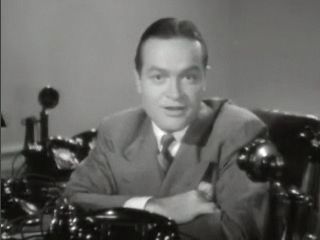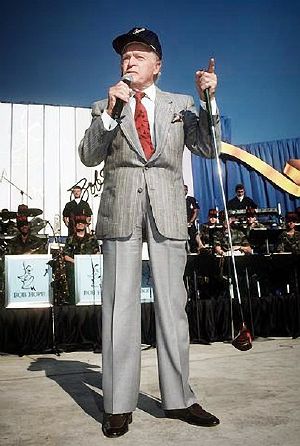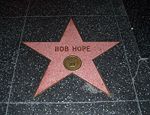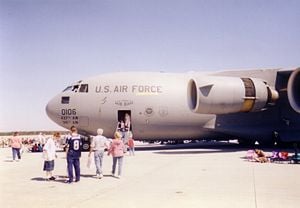Bob Hope
Bob Hope, KBE (May 29, 1903 – July 27, 2003), born Leslie Townes Hope, was an English-born American entertainer whose prolific career spanned nearly a century from 1915 until his death in 2003, and included success in all show business media from vaudeville, and Broadway, to radio, television and movies.
Hope is particularly remembered for his annual Christmas shows, performed live and later televised, aimed at comforting the American Military stationed overseas, many whom he visited during entertainment tours from World War II up until the Persian Gulf War with the USO.
His comedic style, rapid fire and laced with sarcasm, was nevertheless self deprecating and light hearted. Though a favorite target for his particular brand of humor were United States Presidents, his passion lay in serving his adopted country. He once said, "I've got a real crush on America. Nobody ever had a girl like her. Nobody ever gave me as much affection, as much honor, or as much real estate. In a way, in this most democratic of democracies, I sometimes feel like a king."[1]Hope, who earned the moniker "The King of Comedy," was awarded the Presidential Medal of Freedom by President Lyndon B. Johnson for his humanitarian efforts.
Childhood
Hope was born in Eltham, London, England, the fifth of seven sons. His English father, William Henry Hope, was a stonemason and his Welsh mother, Avis Townes, was an operetta singer who also helped subsidize the families' income by leasing out rooms and house cleaning. The family moved to Cleveland, Ohio in 1908. Hope became a United States citizen in 1920 at the age of seventeen after his father became a naturalized citizen. The family struggled financially and so at the age of twelve, Hope began to work at a wide variety of odd jobs. He entered many dancing and amateur talent contests, and in 1915, won a prize at Luna Park, Cleveland, for his impersonation of Charlie Chaplin. He boxed briefly, though unsuccessfully, under the name 'Packy East'. Of that attempt he once quipped, "I was on more canvases than Picasso". Hope dropped out of school at the age of sixteen. In 1967 he recalled of his past, "We'd have been called juvenile delinquents only our neighborhood couldn't afford a sociologist.[2]
Early career and vaudeville
In the late 20's and early 1930's Hope performed on the vaudeville "Gus Sun circuit" which traveled to small towns and rural areas putting on miniature shows called "tabs". [3]
From his biography, Hope said of his time in vaudeville, "...in the days when rooming houses carried signs saying, NO DOGS OR ACTORS ALLOWED, sinced I wasn't considered either one, I usually got a room." Having to perform before a live audience and constantly having to come up with fresh jokes allowed Hope to hone his sense of comedic timing and physical comedy - traits which stayed with him throughout his career despite the fact that he needed a plethora of joke writers to keep up with his rapidfire pace.
From 1926-27, Hope toured with George Byrne under his new name, 'Lester' Hope which he felt was more masculine. Perfecting his technique with Louise Troxell as his sidekick, he would develop a dual role in many of his routines; not only was he the performer, but he could step outside of himself to join the audience in looking and at times criticizing himself. Once he identified with the audience he could overcome poor material and still get laughs. The highlight of his vaudeville career was playing the Imperial Palace in a revue called "the Antics of 1931. However, after six years vaudeville's popularity was waning as large movie theaters with motion picture (sound film) "talking" pictures came on the scene. It was time to seek out a new challenge - the Broadway stage.
Theater
Hope subsequently appeared in several New York City Broadway musicals including Roberta, Say When, the 1936 Ziegfeld Follies, and Red, Hot and Blue with Ethel Merman.
Radio
His career in broadcasting spanned sixty-four years and included a long association with NBC. Hope made his network radio debut in 1937 on NBC. His first regular series for NBC Radio was the Woodbury Soap Hour. A year later The Pepsodent Radio Show Starring Bob Hope began, and would run through 1953. This radio show scored the highest ratings throughout WWII. Hope scored in the top ten highest ratings in radio broadcast for nearly three decades.
Films
Bob Hope, after receiving an honorary Academy Award, returned to Hollywood during the mid-1930s. In The Big Broadcast of 1938, Hope introduced the bittersweet song later to become his trademark, Thanks for the Memory. This song became a major hit and was praised by critics. The sentimental and fluid nature of its music allowed Hope's writers to later invent endless variations of the song to fit specific circumstances, such as bidding farewell to troops while on tour.
According to Hope, early during his film career, a director advised him that movie acting was done mostly with the eyes, resulting in the exaggerated and rolling eye movements which characterized many of his on screen performances.
As a movie star he was best known for My Favorite Brunette and the highly profitable Road to... movies[4] The Bob Hope and Bing Crosby "Road" movies are a set of classics in which Hope starred with Bing Crosby and Dorothy Lamour. He first saw Lamour performing as a nightclub singer in New York and subsequently invited her to work with him on his United Service Organizations (USO tours). Hope and Lamour were lifelong friends, she is the actress most associated with his film career, along with Paulette Goddard, Lucille Ball, Jane Russell, and Hedy Lamarr.
Hope starred in a long string of Paramount Pictures like Fancy Pants, Monsieur Beaucaire, Caught in the Draft and the seven classic 'Road' pictures with Bing Crosby. He made a total of 53 films in his career; in most of them, Bob played a cocky, cowardly type, 'lady's man' who almost never got the girl.[5] Bob Hope never won any Academy Awards for his performances, but the Academy of Motion Picture Arts and Sciences honored him with several special awards and he served as Master of Ceremonies for the Academy Awards ceremony many times. While hosting one of these presentations he famously quipped that Oscar season was, "as it's known at my house, Passover."
Television
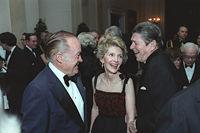
He did many specials for the NBC television network throughout his career. These were often sponsored by Chrysler as Hope served as a spokesman for the firm for many years.
The Bob Hope Special was the longest running television series of all times.[6]
In 1948, Hope began a Christmas tradition of touring overseas military bases, eventually filming these shows for television starting in 1954. 90-minute Bob Hope Christmas Specials were broadcast every holiday season until 1972. Hope's Christmas specials were popular favorites and often featured a performance of "Silver Bells", a song from his 1951 film The Lemon Drop Kid. For the Christmas special the song was done as a duet, often with a much younger female guest star such as Olivia Newton-John or Brooke Shields.
He also made a guest appearance on the NBC show The Golden Girls in the late 1980s. His final television special was in 1996 with [[Tony Danza] who helped Hope present a retrospective about Presidents of the United States.
Overseas with the USO
Hope performed his first United Service Organizations (USO) show on May 6, 1941, at March Field, California. He continued to travel and entertain troops for the rest of World War II and later during the Korean War, the Vietnam War and the 1990–1991 Persian Gulf War. When overseas he almost always performed in Army Fatigues as a show of support for his audience. He was interrupted by gunfire so often that he had a long standing gag, "I wander which of my films they saw?" Hope's USO career lasted half a century, during which he headlined approximately sixty tours. For his service to his country through the USO, Hope was awarded the prestigious Sylvanus Thayer Award by the United States Military Academy at West Point in 1968.
Of Hope's USO shows in World War II, writer John Steinbeck, who was then working as a war correspondent, wrote in 1943:
- When the time for recognition of service to the nation in wartime comes to be considered, Bob Hope should be high on the list. This man drives himself and is driven. It is impossible to see how he can do so much, can cover so much ground, can work so hard, and can be so effective. He works month after month at a pace that would kill most people.[7]
A 1997 act of United States Congress signed by President Clinton named Hope an "Honorary Veteran". He remarked, "I've been given many awards in my lifetime — but to be numbered among the men and women I admire most — is the greatest honor I have ever received."
Interest in sports
Hope had a widely reported passion for sports. He boxed professionally during his youth, was a pool hustler, enjoyed watching American football and was at times a part owner of the Cleveland Indians and Los Angeles Rams. Hope was also famous for his interest in golf. He played in a few Professional Golfers Association of America tour events and the Bob Hope Chrysler Classic is named for him. Hope played golf with nearly every President of the United States from Dwight D. Eisenhower to George W. Bush and often used a golf club as an on-stage prop. .
In 1978, he and Bing Crosby were voted the Bob Jones Award, the highest honor given by the United States Golf Association in recognition of distinguished sportsmanship in golf. Both men are also members of the World Golf Hall of Fame.
Marriages and personal life
According to biographer Arthur Marx, son of Hope's long-time professional rival Groucho Marx, Hope's first wife was his vaudeville partner Grace Louise Troxell. Hope married Troxell on January 25, 1933.
Hope married his second wife, Dolores DeFina, on or about February 19, 1934. A devout Roman Catholic, the Bronx-born nightclub singer of Irish and Italian ancestry was known professionally as Dolores Reade. Hope came to "The Vogue", a Manhattan nightclub where Reade was performing. Accompanied by his friend George Murphy, Hope came to "hear a pretty girl sing." As Bob told it, "She had a low, husky voice - soft and sweet. She sang It's Only A Paper Moon and Did You Ever See A Dream Walking?. That did it! From then on I was at the "Vogue Club" every night, waiting to take Dolores home. A few months later we tied the knot."
They remained together until Hope's death sixty-nine years later, one of the longest-lasting high profile marriages in Hollywood, California history. They adopted four children all from the same orphanage in Evanston, Illinois, who all went on to have successful careers in and out of ntertainment industry.
End of life
Bob Hope remained vibrant as an entertainer through his television specials during the 1980s. However, as the decade ended, with Hope nearing his 90s, his trademark and seemingly invincible sharp delivery had finally begun to noticeably decline. Although still witty and true to his style, his appearances grew less frequent
In 1997, Hope was awarded the Ronald Reagan Freedom Award by Nancy Reagan at the Beverly Hilton Hotel, in Beverly Hills, California. The award is given to "those who have made monumental and lasting contributions to the cause of freedom worldwide," and who "embody President Reagan's lifelong belief that one man or woman truly can make a difference." [8]
Hope celebrated his 100th birthday on May 29, 2003, joining a small group of notable centenarians in the field of entertainment (including Irving Berlin, Hal Roach, Senor Wences, and George Burns.) To mark this event, the intersection of Hollywood and Vine in Los Angeles, California was named Bob Hope Square and his centennial was declared Bob Hope Day in 35 US states. Hope spent the day privately in his Toluca Lake, Los Angeles, California (north of Hollywood) home where he had lived since 1937. Even at 100 years of age and with failing health, Hope is said to have maintained his self-deprecating sense of humor, quipping "I'm so old, they've canceled my blood type." According to one of Hope's daughters, when asked on his deathbed where he wanted to be buried, he told his wife, "Surprise me." He died of Pneumonia two months later at 9:28 p.m., July 27, 2003, at his home in Toluca Lake.
The Basilica of the National Shrine of the Immaculate Conception in Washington, D.C. has a wing dedicated to a miracle in Pontmain, France which was funded by Dolores and Bob Hope in memory of his mother.[9]
Bob Hope is interred in the Bob Hope Memorial Gardens at Mission San Fernando Rey de España in Los Angeles. He appeared in more than 75 films, starred in more than 475 TV programs and 1,000-plus radio programs
Quips and one-liners
A reporter asked him, "What's it like to be Bob Hope? "I wouldn't have it any other way."
Professional awards
- In a 2005 poll to find The Comedian's Comedian, he was voted among the top 50 comedy acts ever by fellow comedians and comedy insiders.
Academy Awards
- 2 Special Awards, 1941 and 1966
- 2 Honorary Oscars, 1945 and 1953
- Jean Hersholt Humanitarian Award, 1959
Stars on the Hollywood Walk of Fame
- Motion picture star at 6541 Hollywood Blvd.
- Radio star at 6141 Hollywood Blvd.
- TV star at 6758 Hollywood Blvd.
- Live theatre special plaque at 7021 Hollywood Blvd.
Honors
Medals
- Congressional Gold Medal (June 8, 1962)
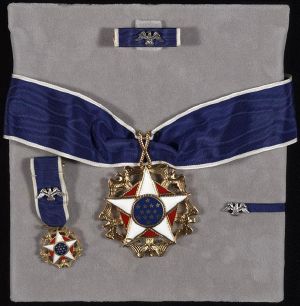
- Presidential Medal of Freedom (awarded by Lyndon B. Johnson, January 20, 1969)
- Sylvanus Thayer Award, United States Military Academy at West Point, 1968
- Ronald Reagan Freedom Award, 1997
Titles and designations
- Honorary mayor of Palm Springs, California (1950s)
- Hasty Pudding Man of the Year (first awardee, 1967)
- Board of Governors of the National Space Institute, forerunner of the present-day National Space Society, a nonprofit educational space advocacy organization founded by Dr. Wernher von Braun (1974)
- Honorary Veteran of the United States Armed Forces, a tribute from the United States Congress given in recognition of the entertainment he provided US troops during war and peacekeeping missions (October 29 1997)
- Honorary Order of the Knight Commander of the British Empire (KBE) In recognition of his contributions to film, to song, and to the entertainment of troops in the past. (1998). He had previously been made an Honorary Commander of the British Empire (CBE) in 1976.
- Knighthood from the Knights of Malta and the Order of St. Sylvester from the Vatican
- Silver Buffalo Award (highest adult award given by the Boy Scouts of America)
- The Honorable Order of Kentucky Colonels.
- Made a Knight Commander of the Order of St. Gregory the Great by Pope John Paul II in 1998[10]
Legacy
- PGA Bob Hope Chrysler Classic, which was an existing tournament (The Desert Classic) renamed in recognition of the comedian's lifelong passion for the game, 1966
- Bob Hope Drive, streets in both Burbank, California and Rancho Mirage, California. The Rancho Mirage street is the location of Eisenhower Medical Center which Hope and his wife were instrumental in creating.
- The Spirit of Bob Hope, a United States Air Force C-17 Globemaster III aircraft (1997) [2]
- Bob Hope: 50 Years of Hope, an exhibition of Hope's service of entertaining the United States military at the National Museum of the United States Air Force near Dayton, Ohio [3]
- Bob Hope Square (naming of the intersection at Hollywood and Vine in Los Angeles to commemorate Hope's 100th birthday, May 29, 2003)
- Bob Hope Airport: Hope had joked with his family that he wanted an airport named for him after hearing in 1979 that Orange County, California officials had renamed their airport after John Wayne. On November 3, 2003 the Burbank-Glendale-Pasadena Airport Authority voted unanimously to rename the facility and on November 18, 2003 the Glendale, California, and Burbank, California city councils voted unanimously to approve it. Pasadena, California followed on December 10. The Federal Aviation Administration|FAA three-letter designation BUR did not change. A rededication ceremony took place on December 17, the 100th anniversary of the Wright brothers' first powered flight.
- Bob Hope Theatre, a renovated Fox Theatre movie house in Stockton, California (2004)
- USNS Bob Hope (T-AKR-300) , one of the few list of military vessels named after living Americans|naval vessels to be named for a living person
- 2829 Bobhope|Asteroid 2829 Bobhope
- The Bob Hope Theatre, an amateur theatre (although professional musicians receive payment) in Eltham, London where he was born.
- Blue plaque at 44, Craigton Road Eltham, London, Hope's place of birth.
- The Bob Hope Theatre, an on-base movie theatre and lecture hall at Marine Corps Air Station Miramar, San Diego, California.
- "The Bob Hope Theatre", a 392-seat facility at Southern Methodist University in Dallas, TX. It has a proscenium stage, continental seating and a hydraulic orchestra pit.[11]
- Oscars hosted: 12th, 14th, 15th, 37th, 38th, 39th, 40th, and 50th.
- Oscars co-hosted: 17th, 18th, 25th, 27th, 30th, 31st, 32nd, 33rd, 34th, and 47th.
Filmography
Features
- The Big Broadcast of 1938 (1938)
- College Swing (1938)
- Give Me a Sailor (1938)
- Thanks for the Memory (1938)
- Never Say Die (1939)
- Rhythm Romance (1939)
- The Cat and the Canary (1939)
- Road to Singapore (1940)
- The Ghost Breakers (1940)
- Road to Zanzibar (1941)
- Caught in the Draft (1941)
- Nothing But the Truth (1941)
- Louisiana Purchase (1941)
- My Favorite Blonde (1942)
- Road to Morocco (1942)
- Star Spangled Rhythm (1942)
- Combat America (1943) (documentary)
- They Got Me Covered (1943)
- Let's Face It (1943)
- The Princess and the Pirate (1944)
- The Story of G.I. Joe (1945) (voice)
- Road to Utopia (1946)
- Monsieur Beaucaire (1946)
- My Favorite Brunette (1947)
- Variety Girl (1947)
- Where There's Life (1947)
- Road to Rio (1947)
- The Paleface (1948)
- Sorrowful Jones (1949)
- The Great Lover (1949)
- Fancy Pants (1950)
- My Favorite Spy (1951)
- The Lemon Drop Kid (1951)
- The Greatest Show on Earth (1952) (Cameo)
- Son of Paleface (1952)
- Road to Bali (1952)
- Off Limits (1953)
- Scared Stiff (1953) (Cameo)
- Here Come the Girls (1953)
- Casanova's Big Night (1954)
- The Seven Little Foys (1955)
- That Certain Feeling (1956)
- The Iron Petticoat (1956)
- Beau James (1957)
- Paris Holiday (1958)
- Alias Jesse James (1959)
- The Five Pennies (1959) (Cameo)
- The Facts of Life (1960)
- Bachelor in Paradise (1961)
- The Road to Hong Kong (1962)
- Critic's Choice (1963)
- Call Me Bwana (1963)
- A Global Affair (1964)
- I'll Take Sweden (1965)
- The Oscar (1966) (Cameo)
- Boy, Did I Get a Wrong Number! (1966)
- Not with My Wife, You Don't! (1966) (Cameo)
- Eight on the Lam (1967)
- The Private Navy of Sgt. O'Farrell (1968)
- How to Commit Marriage (1969)
- Cancel My Reservation (1972)
- The Muppet Movie (1979)
- Spies Like Us (1985)
- A Century of Cinema (1994) (documentary)
- That Little Monster (1994)
- Off the Menu: The Last Days of Chasen's (1997) (documentary)
Short subjects
- Going Spanish (1934)
- Paree, Paree (1934)
- The Old Grey Mayor (1935)
- Double Exposure (1935)
- Calling All Tars (1935)
- Soup for Nuts (1935)
- Watch the Birdie (1935)
- Shop Talk (1936)
- Don't Hook Now (1938)
- Screen Snapshots Series 19, No. 6 (1940)
- Hedda Hopper's Hollywood No. 4 (1942)
- Strictly G.I. (1943)
- Show Business at War (1943)
- The All-Star Bond Rally (1945)
- Hollywood Victory Caravan (1945)
- Weekend in Hollywood (1947)
- March of Time Volume 14, No. 1: Is Everybody Listening? (1947)
- Screen Actors (1950)
- You Can Change the World (1951)
- Screen Snapshots: Memorial to Al Jolson (1952)
- Screen Snapshots: Hollywood's Invisible Man (1954)
- Screen Snapshots: Hollywood Beauty (1955)
- Showdown at Ulcer Gulch (1956)
- Screen Snapshots: Hollywood Star Night (1957)
- The Heart of Show Business (1957)
- Rowan & Martin at the Movies (1968)
Notes
- ↑ Hope, Bob with Melville Shavelson. Don't Shoot, It's Only Me. (1990) Putnam's Sons: ISBN 0399135189
- ↑ http://www.loc.gov/exhibits/bobhope/early.html
- ↑ http://www.loc.gov/exhibits/bobhope/vaude.html
- ↑ http://www.google.com/search?sourceid=navclient&ie=UTF-8&rlz=1T4GGIC_enUS212US212&q=Bob+Hope%27s+movie%2c+Road+to
- ↑ http://www.tvparty.com/movbob.html
- ↑ http://www.tvparty.com/movbob.html
- ↑ John Steinbeck (1958) Once There Was A War, New York: Bantam, p.65.
- ↑ http://www.reaganfoundation.org/programs/cpa/awards.asp
- ↑ http://www.nationalshrine.com/site/apps/nl/content2.asp?c=etITK6OTG&b=309286&ct=160562
- ↑ PQArchiver.com
- ↑ [1]
ReferencesISBN links support NWE through referral fees
- Faith, William Robert. Bob Hope: A Life in Comedy. Putnam's Sons (1982). ISBN 0399126279
- Hope, Bob with Melville Shavelson. Don't Shoot, It's Only Me. (1990) Putnam's Sons: ISBN 0399135189
- Morella, Joe and Edward Z. Epstein and Eleanor Clark. The Amazing Careers of Bob Hope. (1973) Arlington House ISBN 0870001914
External links
- Official website
- Bob Hope at the Internet Movie Database
- Bob Hope at the Internet Broadway Database
- Bob Hope at the Radio Hall of Fame
- Bob Hope at the Notable Names Database
- "Hope-ful Century of Wit and Laughter" MSNBC.msn.com Tribute
- "100 Years of Hope: The Early Years" MSNBC.msn.com Tribute
- "100 Years of Hope: Slapstick and the Great Divide" MSNBC.msn.com Tribute
- Bob Hope's Official Myspace page
- Bob Hope Show radio archive (27 episodes from Bob Hope radio Show)
- News and articles about Bob Hope
- CNN obituary
- Satellite photograph of Hope's second home in Palm Springs, California.
- Bob Hope Memorial at Find A Grave
- MaritimeQuest Tribute to Bob Hope
- A National Salute to Bob Hope and our Military (currently inoperative)
| Persondata | |
|---|---|
| NAME | Hope, Bob |
| ALTERNATIVE NAMES | Hope, Leslie Townes |
| SHORT DESCRIPTION | entertainer |
| DATE OF BIRTH | May 29 1903 |
| PLACE OF BIRTH | Eltham, London, England |
| DATE OF DEATH | July 27 2003 |
| PLACE OF DEATH | Toluca Lake, California, USA |
Credits
New World Encyclopedia writers and editors rewrote and completed the Wikipedia article in accordance with New World Encyclopedia standards. This article abides by terms of the Creative Commons CC-by-sa 3.0 License (CC-by-sa), which may be used and disseminated with proper attribution. Credit is due under the terms of this license that can reference both the New World Encyclopedia contributors and the selfless volunteer contributors of the Wikimedia Foundation. To cite this article click here for a list of acceptable citing formats.The history of earlier contributions by wikipedians is accessible to researchers here:
The history of this article since it was imported to New World Encyclopedia:
Note: Some restrictions may apply to use of individual images which are separately licensed.
